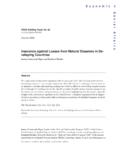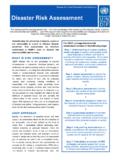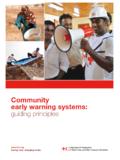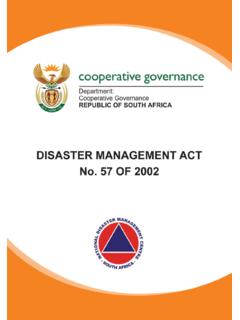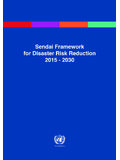Transcription of Disaster Risk Management for Health Fact Sheets …
1 Global Platform - May 2011 Disaster Risk Management for Health Fact Sheets Disaster Risk Management for Health OVERVIEW What is Disaster risk Management for Health ? Disasters and other emergencies often result in signifi-cant impacts on people s Health , including the loss of many lives. Every new threat reveals the challenges for managing Health risks and effects of emergencies and disasters. Deaths, injuries, diseases, disabilities, psychosocial problems and other Health impacts can be avoided or reduced by Disaster risk Management measures involving Health and other sectors. Disaster risk Management for Health is multisectoral and refers to: the systematic analysis and Management of Health risks , posed by emergencies and dis-asters, through a combination of (i) hazard and vulnerability reduction to prevent and mitigate risks , (ii) preparedness, (ii) response and (iv) recovery measures.
2 The traditional focus of the Health sector has been on the response to emergencies. The ongoing challenge is to broaden the focus of Disaster risk Management for Health from that of response and recovery to a more proactive approach which emphasises preven-tion and mitigation, and the development of community and country capacities to provide timely and effective response and recovery. Resilient Health systems based on primary Health care at community level can reduce underlying vulnerability, protect Health facilities and services, and scale-up the response to meet the wide-ranging Health needs in disasters. Advocating Disaster risk Management for Health These advocacy materials are an introduction for Health workers engaged in Disaster risk Management and for multi-sectoral partners to consider how to integrate Health into their Disaster risk Management strategies.
3 Why is there a need for Disaster risk Management for Health ? Natural, biological, technological and societal hazards put the Health of vulnerable populations at risk and the potential to cause significant harm to public Health . Examples of these hazards are as follows: Natural: earthquake, landslide, tsunami, cy-clones, flood or drought. Biological: epidemic disease, infestations of pests. Technological: chemical substance, radiologi-cal agents, transport crashes. Societal: conflict, stampedes, acts of terrorism. Disasters, emergencies, and other crises may cause ill- Health directly or through the disruption of Health systems, facilities and services, leaving many without access to Health care in times of emergency. They also affect basic infrastructure such as water supplies and safe shelter which are essential for Health .
4 International consensus views disasters as barriers to progress on the Health -related Millennium Develop-ment Goals (MDGs), as they often set back hard earned development gains in Health and other sec-tors. Disaster risk Management for Health is EVERYBODY'S BUSINESS The overview places Disaster risk Management in the context of multi-sectoral action and focuses on the ge-neric elements of Disaster risk Management , including potential hazards, vulnerabilities of a population, and capacities, which apply across the various Health do-mains. The accompanying fact Sheets identify key points for consideration within a number of essential Health do-mains. However, importantly, all Health domains are inter-linked; each fact sheet should therefore be considered as part of the entire set and in conjunction with the overview.
5 Further information, contact: WHO - Jonathan Abrahams (e-mail: Country capacities and needs Progress has been made at global, regional, national and community levels, but the capacity of countries for risk reduction, emergency preparedness, response and recovery remains extremely variable. The 2007 WHO global assessment found that less than 50% of national Health sectors had a specified budget for emergency preparedness and response. 7 Factors affecting capacity include: weak Health and Disaster Management systems. lack of access to resources and know-how. continuing insecurity due to conflict. But a number of high-risk countries have strengthened their Disaster prevention, preparedness and response systems; in some countries, the Health sector has led initiatives developing multi-sectoral approaches to dis-aster risk Management .)
6 Natural Disasters Over a twenty year period, in excess of 8500 natural disasters occurred, affecting more than billion peo-ple. 2 A comparative analysis of Disaster statistics in Latin America found that for each Disaster listed in global Disaster databases, there are some 20 other disasters with destructive impact on local communities that are not In Latin America, the cumula-tive effect of ten years of local disasters were found to have had a greater impact on the poor than any one-off event. 4 The incidence of natural disasters has been increasing and the impact of climate change will be to increase the risk for millions of individuals, their homes, their com-munities, and the infrastructure that supports them. Biological Disasters During the last few decades, biological emergencies have assumed an increasing importance: major out-breaks related to new and re-emerging infectious diseases such as SARS, influenza (H1N1 and H5N1) and cholera.
7 Technological disasters The International Federation of the Red Cross has es-timated that between 1998 and 2007, there were nearly 3 200 technological disasters with approximately 100 000 people killed and nearly 2 million people af-fected. 5 Societal Disasters Complex emergencies, including conflict, continue to affect tens of millions of people, causing displacement of people both inside and across borders. In 2010 there were an estimated total of 27 million persons who re-mained internally displaced by armed conflict across the world. Disaster risk Management for Health in context Sustainable development Disaster risk Management has emerged as a core element of sustainable development and an essential part of a safer world in the twenty-first century.
8 6 Re-ducing risk is a long-term development process, managed by communities and individuals working to-gether. Health Systems Health care systems provide core capacities for disas-ter risk Management for Health . Some countries affected by disasters have limited basic Health services and infrastructure, which in itself hugely compounds the challenges of Disaster response. Countries with well-developed systems are often much more resilient and better prepared for disasters. Primary Health care (PHC) focuses on basic services to improve Health status, which in turn builds community resilience and provides the foundation for responding to emergencies. Policies and strategies focusing on PHC can contribute to decreasing vulnerability and preparing households, communities and Health sys-tems for disasters.
9 Following a Disaster , focus is often given to acute care needs and specialist interventions; whilst important, it is usually chronic and pre-existing conditions that prove the largest burden of disease. Community-based actions are at the front line of pro-tecting Health in emergencies because: local knowledge of local risks is used to address the actual needs of the community. local actions prevent risks at the source, by avoiding exposure to local hazards. Democratic Republic of Congo (WHO/M. Kokic) Developed by the World Health Organization, United Kingdom Health Protection Agency and partners Further information, contact: WHO - Jonathan Abrahams (e-mail: a prepared, active and well-organized community can reduce risks and the impact of emergencies.)
10 Many lives can be saved in the first hours after an emergency through community response be-fore external help arrives. Hospitals and Health infrastructure Health systems are composed of public, private and nongovernmental facilities which work together to serve the community; these include hospitals, pri-mary Health care centres, laboratories, pharmacies and blood banks. Safe hospitals programmes ensure Health facilities are safely built to withstand hazards, remaining operational in emergencies. Developing adaptable and resilient Health care sys-tems Surge capacity: Health care systems need to pre-pare to cope with large numbers of patients. This may require mobilising staff around the country to aid affected areas. Flexibility in Health care systems: Flexibility to de-liver different functions is an essential component of Health care delivery.












